

|
|
Download
FULLSIZE MoBAG Board |
|
OMAKE: GAME |
January th, 2004 |
What Is MoBag?
MoBag, also called M-Bag, or just 'Bag' is a street game played underground, in a Zero-P environment, in the Universe of Pastel.
The local equivalent of gravity in Pastel is called Proxikinesion. Proxikinesion, 'P-Forces', cause matter to be attracted to the 'top' and 'bottom' surfaces of the rectilinear continents equally, and there are cities on the underside Twilands as well as the topside Dayplains of the flying continents of Pastel. The Pastellians use specially curving roadways that go through the Underground inside the continents to move smoothly, more or less, from the Dayplain side to the Twiland side, where everything is effectively upside-down relative to the other.
The force of Proxikinesion is created by a layer of matter, called the P-Layer, that runs through the middle of the rectilinear continents, like the cream filling in an Oreo cookie, or perhaps even more like the filling in a vanilla wafer. It pulls top and bottom to itself, to the middle of the contenent. But it has no force laterally, to the sides of the continent.
The value of 'P' drops to near zero at the exact crossover point, in the middle of the P-Layer, and in addition to crossover traffic tunnels, and the odd Low-P factory, the Pastellians have also excavated 'Low-Parks' or Low-P playgrounds which can be enjoyed for a nominal fee. Many of the older Low Parks are rather run-down, and have become hangouts for disaffected youth.
There is a game some younger Pastellians play in the Low-Parks. It is a 'street' game, rather frowned upon...if they catch you they often throw you out of the Low-Park. But it still gets played, just as in our world, skateboarders will do what they want regardless. So 'extreme sports' type people play M-Bag in the Low-Parks. M-Bag stands for "Momentum Bag" and basically what you do is fill a bag, sewn up to be covered with cloth or leather belt handles, with bricks and laundry to pad the bricks, and take it to a Low-Park to play. Two teams face of in the Low P environment and carefully set the bag roughly in the middle of the surroundings.
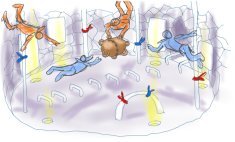
Then they pick a set of 'scorebases'..could be anything, basically a set of target locations. These scorebases are defined by a Base-Rag, dyed with glowing Chatoyance Dye, affixed to that location. Then get this...rather than try to knock the bag to the goals of the scorebases, the object is to latch onto the bag, floating in the middle, and then crawl and twist over the bag -maybe struggling with others on the bag at the same time- and use the handles to throw oneself off so one lands or connects with a scorebase in such a way that the Base-Rag can be taken. The bag MUST be grabbed first, before an attempt on a Base-Rag can be made. The bag, being very massive, has a lot of inertia, and so it moves less than the people throwing themselves off it. A good rule of thumb is that the bag, aboveground, has to weigh more than at least four players. That's why they use bricks. However, bricks are hard to collide with, and that's why the bricks are padded. Needless to say, a helmet and pads are mandatory equipment for M-Bag, because players tend to fling themselves off at any old angle when they get carried away with the game. The goal of the game is be the first to collect all of the other team's Base-Rags... or to have at least one teammate still able to play, should the other side be wiped-out with collision injuries.
This bonus feature provides a tabletop means to simulate the play of MoBag. One need simply download and print out the MoBag board sheet, grab three standard 6-sided dice (3D6), and use the game rules provided below. Good Bagging!
RULES FOR PLAY
MoBag, the tabletop simulation, is a game for two people. Carefully cut away the provided chits from the printed version of the MoBag sheet. One should end up with a playing board, and twelve chits consisting of six Players and six base rags. The game board represents an enclosed chamber, deep underground, called a Low-Park, or Low-Proxikinesion Park.
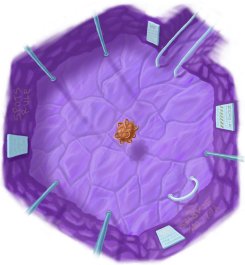
Each Player chooses a team, either the Yellow Scarves, or the Spots.
Each Player chit has on it the name of the Player, and two stats. These stats are used to determine success or failure in actions within the game. Because not all printers are of quality, here are the characters, and their stats below:
|
Team Yellow Scarf
Greige
Kuro ZG 2 ZT 2 |
Team Spots
Umber
Rojo ZG 0 ZT 4 |
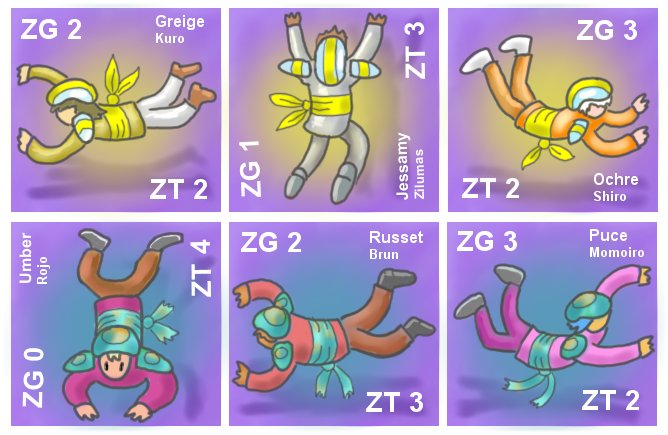
THE STATS
The two stats all MoBag atheletes have are ZG and ZT. These stand for Zero-Grab and Zero-Tumble. They represent any special talent that a particular Player has in handling themselves within a Zero-P environment.
Zero-Grab is the skill and talent involved in using any available limb to snag, grasp, hold, manipulate, and aim oneself, or another mass, in Zero-P.
Zero-Tumble is the skill and talent involved in twisting in the air, resisting, avoiding or causing impacts, springing, kicking, or pushing off of walls or other surfaces in a controlled manner, and managing unexpected collisions in Zero-P.
The higher the value, the greater the talent and skill.
SETTING UP THE BOARD
The Players take turns placing chits onto the game board. The three glowing Base-Rags for each team must be laced on hexes marked 'BASE'. These rags are the goal of the game, whoever collects all three that belong to the other team first, wins. It is a good idea to place the Base-Rags in strategic positions, that can be guarded.

The remaining Teammate-chits can be placed on any hex that has a 'G' in it, OTHER than those immediately surrounding the Momentum-Bag floating in the center of the park. No Player may start the game touching the M-Bag.
The 'G' in certain hexes represents a location where a solid and useful grip on an object in the environment is possible within the Low-Park. Only in such hexes is it possible to stop motion, hang on, and rest. Whenever a Teammate chit is at rest on a 'G' hex, the Teammate is assumed to be solidly holding onto a pipe, bar, or handle. Some 'G' hexes offer plusses, because it is possible for a Teammate to have better than average control when leaping or pushing off from that location, due to a combination of factors. Those plusses for a given 'G' hex are added to the appropriate stat when an action is taken from that Hex, provided that the character was previously stable, clinging, and at rest there. Merely passing through such a bonus 'G' hex offers no benefit.
Once all chits are placed, the game is ready to play.
ZERO-P MOVEMENT
The
most common action in the game is motion, and thus is the heart of
the game.
Players
do not alternate turns, but act together on each turn. Speed of
motion determines which Player acts before the other, however.
On their turn, a Player may choose to pass, or to move one of their team members (chits) to advance their goals in the game.
A team member, a Teammate, clinging to a stable pipe or bar (a 'G' hex on the board) may, on a given turn, move from that spot by pushing off with hands or feet, to fly across the air in Zero-P.
To do this, the Player of that teammate chooses the teammate to move, and then states the direction of travel. Movement may only be made along a straight line following the faces of the hexes on the board, and once motion has begun, no change in direction is possible. A teammate may not, for instance, alter their direction of travel in the middle of the air, with nothing around them. The teammate must continue motion in that same straight line until some sort of collision, either planned, or unplanned, affects them (such as a grab or a tackle).
Once a teammate and direction has been choosen, the Player must then determine a speed.
Speed is determined by the number of six-sided dice used for the leap, and for the inevitable end of the leap.
One
die is slow, two dice is risky, and three dice is insane.
However,
the highest number rolled for motion, always
acts first.
The total number generated by a roll of the dice equates to the number of hexes the teammate will move each turn, until they stop moving do to some action or interaction. For example, if a Player chooses but one die, and rolls a four, then the teammate chit is moved four hexes each turn in a straight line. If they had rolled a one, then the teammate chit would move but one hex per turn.
It is important to note that higher speeds incur vastly greater risks.
Once in motion, the teammate must continue, helplessly, until an opportunity to grab, to rebound, or to collide occurs.
GRABBING
The next most common action is grabbing.
To attempt a grab, a teammate chit must be on a hex containing a 'G'. A teammate cannot grab on any other hex.
For any non-movement action in MoBag, the base game mechanic is the always the same: the Player must attempt to roll a die, or dice, and get a number EQUAL TO, or ABOVE, SEVEN.
To accomplish this, a Player must roll TWO DICE, add the values, and then add or subtract any bonuses or penalties to the result of the die roll. The final product determines success or failure.
One bonus that is added are the teammate stat values. Teammates have two stats, Zero-Grab, and Zero-Tumble. In grabbing, Zero-Grab is used.
When attempting a basic grab at an object, such as a pole, or the floating M-Bag, the Player rolls two dice, and adds the Zero-Grab stat of the attempting teammate. This result is the Grab Value. This is the most basic grab situation. If the Grab-Value result is equal to, or above seven, then the grab was successful.
MOTION AND GRABBING
Speed of motion affects grabbing a great deal. The faster a teammate is moving, the more difficult it is to grab any object.
To understand how this works, imagine that a Player has choosen two dice to roll for speed, and leaps a teammate into the void, towards the M-Bag in the center of the board. The Player rolls a seven, which easily beats his opponent Player, rolling a single die for his own teammate. The first Player therefore acts first.
This allows that Player to immediately zip to the M-Bag, where, in passing through a 'G' hex, their teammate has a chance to grab the M-Bag. This is where speed becomes an issue.
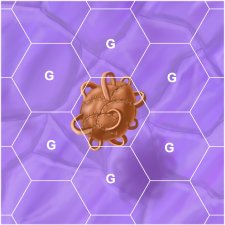
Let's say that the trip to the 'G' location of the M-Bag was three hexes. That leaves four speed points left over. These extra 'Overshoot' points are subtracted from any Grab-Value the Player then immediately rolls for. Obviously, the higher the Overshoot, the less likely a succesful grab.
So, so far, we have a leap, (roll two dice for speed, result was a seven), crossing to the M-Bag (three hexes to the nearest 'G' hex), and then a roll on two dice (plus a Zero-Grab teammate stat bonus) to get a Grab-Value. The Overshoot beyond the M-Bag is four, so four is subtracted from the Grab-Value, and whatever the Grab-Value is after that subtraction is the actual chance of success. If it is equal to, or over seven, then the Grab was a success. If not, then the teammate fails the grab and flys past the bag the remaining four hexes.
On the same Player's next turn, that teammate must move another seven hexes, or attempt to, unless they can make another grab attempt (if possible) to stop, or they collide with a wall hex.
COLLISIONS
A Teammate, in motion, may collide with a wall hex. In such a collision, the Player will want to avoid a crippling injury for the Teammate by rolling a Zero-Tumble Rebound.

If successful, the teammate may instantly pick a new straight-line direction, and continue motion up to the limit of their current speed. This prevents an injury that demands that the teammate be removed from the board, and thus, out of the game.
To make a Zero-Tumble Rebound, the Player will take two dice, and roll them. Then the Player will add the value of the Teammate's Zero-Tumble stat to the result of the dice. This final number is the Tumble-Value. The Tumble-Value must then equal, or exceed, seven to succeed.
If the value is less than seven, the Tumble has failed, and the teammate slams into the wall at some horrible speed, breaking an arm, a leg, or getting the wind knocked out of them, being terribly bruised, or some other unhappy injury. The teammate chit is removed from the board, and is out of the game. M-Bag is a brutal sport.
Should a collision occur between two teammates, of any team, each will roll a Tumble Value, and if successful, may perform a Zero-Tumble Rebound off of the other teammate. Any teammate that fails their Tumble-Value roll suffers a collision injury just as if they had hit a wall, and is removed from play. Getting kicked in the head by a Rebounding player hurts just as much as smashing into a wall. Such an unhappy collision result between teammates is called a Tackle.
Deliberately initiating such a collision may be the only way to unseat, or scare away, a guarding teammate for the other side.
SCORING
To score, a Teammate MUST first grab onto the M-Bag in the center of the Park, and THEN throw themselves off to a Scorebase, to collect the Base-Rag there. A Base-Rag is only legal to be collected after the M-Bag has been grabbed imediately before. To put it another way, the only way to collect a Base-Rag is to launch from the M-Bag.

Should any teammate rebound off of a BASE where a Base-Rag has been placed, then they are considered to automatically have grabbed the Base-Rag, scoring one point for their team. This automatic grabbing of the Base-Rag is allowed to speed play. If the players want a longer game, they may roll a Zero-Grab in addition to The Zero-Tumble Rebound, to grab the Base-Rag, but this is considered excessive.
Whichever team scores all three Base-Rags of the opposing team, or retains at least one functional teammate should the other team be wiped out, wins the game.
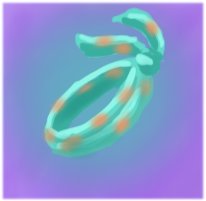
CONCLUSION
MoBag is a tough, brutal street sport, played fast and furious, with little care for personal safety. Hopefully this download-and-play tabletop game will give the Player a feel for this otherworldly, indeed other-cosmic, sport.

PASTEL
DEFENDER HELIOTROPE
By
Jennifer Diane Reitz
![]()
A
Part Of Jenniverse.com
All
Website Contents, including all characters,
images,
artwork, text, and any other contents are
Copyright
© 2004 by Jennifer Diane Reitz
All
Rights Reserved Worldwide

Anti-Spam
Address Image
To
contact Jennifer you may use either of the above addresses.
You
may have to type them in yourself, if your browser does
not
support Javascript. Otherwise, click on the button!
LINK
FREELY
You
may link to this site freely!
You
may FREELY use any JENNYVERSE title image as a link button!